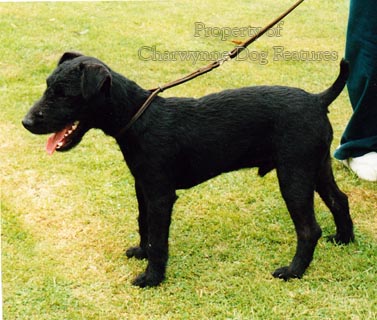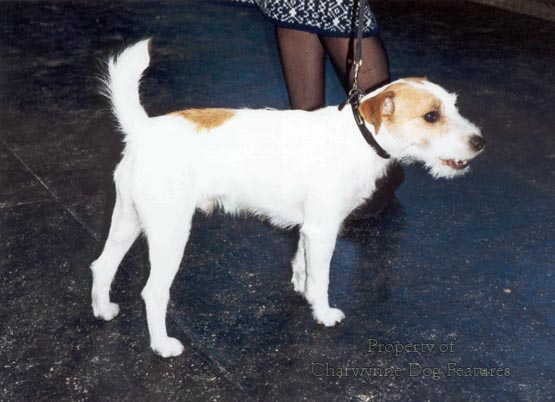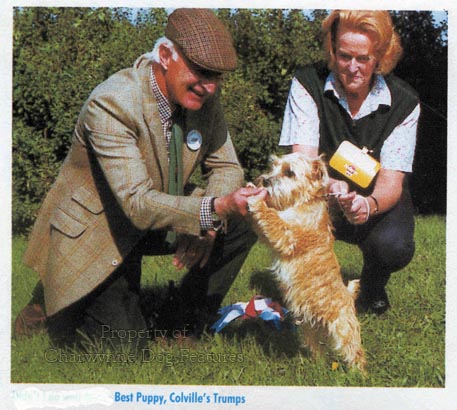375 Digging out Old terriers
DIGGING OUT THE TERRIERS
by David Hancock
 There is something uniquely British about terriers, our Territorial Army once being proud to have the soubriquet of The Terriers used to denote its character. There are of course terrier breeds in other countries, as the Black Russian, the Australian, the Brazilian, the Cesky and the German Hunt Terriers demonstrate. But I suspect that in most cases the inspiration, type and breeding stock came from here. If you favour the terrier type, there is a wide range to choose from. You could try a Capheaton, a Balla, a Patterdale, a Fell, a Plummer or a Lucas from here, or even a Rat Terrier or a Toy Fox Terrier from America, If you want a really big one, try the Black Russian terrier, which can be 30" at the shoulder or mastiff-size. The American hunters have developed a 90lb Airedale, half again as big as ours, of interest if you are seeking a big hunting dog. You will have problems getting a Balla terrier, with perhaps only 15 pure Ballas in England. They come from Ballanantey in Ireland and are red prick-eared foot-high dogs, with strong sporting instincts.
There is something uniquely British about terriers, our Territorial Army once being proud to have the soubriquet of The Terriers used to denote its character. There are of course terrier breeds in other countries, as the Black Russian, the Australian, the Brazilian, the Cesky and the German Hunt Terriers demonstrate. But I suspect that in most cases the inspiration, type and breeding stock came from here. If you favour the terrier type, there is a wide range to choose from. You could try a Capheaton, a Balla, a Patterdale, a Fell, a Plummer or a Lucas from here, or even a Rat Terrier or a Toy Fox Terrier from America, If you want a really big one, try the Black Russian terrier, which can be 30" at the shoulder or mastiff-size. The American hunters have developed a 90lb Airedale, half again as big as ours, of interest if you are seeking a big hunting dog. You will have problems getting a Balla terrier, with perhaps only 15 pure Ballas in England. They come from Ballanantey in Ireland and are red prick-eared foot-high dogs, with strong sporting instincts. 
The list of terrier breeds as recognised by the Kennel Club could have looked so very different had fate played another role. In place of famous breed names like the Sealyham, Scottish, Welsh, Irish, Border, Norfolk and Parson Russell Terrier, we could so easily have ended up with the Trumpington, Cowley, Bewcastle, Elterwater, Suffolk, Will Norris and Squire Poole terrier. In the early nineteenth century, many localities, even some valleys, had their own favoured type of terrier, some of which became swept up in a distinct form we now call a breed.
A comparable situation occurred in other types of dog in other countries, as the mountain dogs of Switzerland: Bernese, Appenzeller, Entlebucher and Great Swiss illustrate. The setter breeds provide another example of surviving breeds representing today the much wider range of colours and types which existed in the last century, as the milk-white Llanidloes, the liver and white of Naworth and Featherstone Castles, the tricolour of Lord Lovatt and the Earl of Southesk and the jet black of Lord Ossulston once did. In the spaniel breeds, we could have preserved as distinct breeds the Devon, Welsh and Black Cockers, now subsumed into modern breeds. 
Not much has been written about the terrier types which did not achieve KC breed status, mainly because terrier work was not a job for the educated monied classes who could have written books about them. As a consequence, it is probably easier to research just one setter breed than all of our lost terrier breeds, such is the disparity of written material. But now, just in time, as the new millennium unfolds, the working terrier breeders, who never follow fad or fashion, are at work again. Just as a working Clumber Spaniel, half the weight of the show dog and with sounder hips and eyes, is being promoted, so too are recast working Sealyhams and Bedlingtons, a resurrected Lucas Terrier and a new breed, the Plummer Terrier.
The Plummer Terrier, named after its creator, schoolmaster turned writer, the late Brian Plummer, prolific author, mainly on lurchers and terriers, is steadily gaining ground. Between 11½ and 13½ inches at the shoulder, smooth coated, with a head displaying signs of both Bull Terrier and Fox Terrier ancestry and a striking fiery tan colour with white finching, these dogs were developed in a hard school and now breed consistently true to type. There are two breed clubs, the older one, the association, having a stud book going back to the early 1950s. There is talk of an approach to the Kennel Club for recognition; this would bring immortality to the breed's founder but not necessarily ensure its perpetuation, if the English White Terrier is anything to go by. 
Both the Plummer Terrier and the Lucas Terrier enthusiasts observe written and approved breed standards, although each of the two breed clubs in each breed work to different standards, something to be rationalised in the long term. Most of the Plummers have been sired by working terriers owned by professional terriermen working for foxhound packs. They have exceptional noses and it would be difficult to find better ratters. One is being used to track deer, rather as the Germans use their 'teckels'. They can display what French huntsmen would term 'excessivement meurtrier' or be, more euphemistically, determined vermin-killers. They are certainly not dogs for elderly spinsters in Surbiton!
The working side of the Lucas was banded together in the Sporting Lucas Terrier Club, with Paul Hawkes, when terrierman to the Tynedale Hunt as its first chairman. I am in the unique position of having judged the annual show of both Lucas Terrier breed clubs and the Belvoir Castle show of the Plummer Terrier Association in 2003. This gave me the chance to assess the breeding stock in both breeds. I believe it would be an enormous pity to lose the rich tan coat colour from the Sporting Lucas Terrier genepool; just about every entry at their Bramham show of 2000 being mainly white. An outcross to the Norfolk Terrier is being actively pursued to restore this feature. The Plummer Terriers I judged represented sufficient stock, in my view, to obviate the need for outside blood.
I was heartened by the sincere motivation of the Sporting Lucas fanciers, who held a seminar in Sussex in 2003, superbly organised by Susan Hard and her colleagues, to consider the best interests of the future breed. There was no mention of challenge certificates, rosettes, cups or judging appointments, just an earnest desire to seek out stock worth breeding from and take steps important for the improvement of this emergent breed. Any breed of dog dubbed 'rare' or emergent is vulnerable to the less pleasant side of human nature: those who seek personal ornaments or those who wish to produce as many pups as possible in the shortest possible time, to fill their wallets, whatever the quality. Sadly in Britain, there is no way to deny the latter their unworthy income.
The Lucas Terrier was described by its creator Sir Jocelyn Lucas, famous for his Ilmer kennel of Sealyhams, as "death on rats and rabbits", and this is no ornamental breed. Seeking a smaller working Sealyham, Sir Jocelyn outcrossed to a red Norwich Terrier, and, finding the crossbred puppies so attractive he set to in an attempt to stabilise this type. The Lucas Terrier enthusiasts of today are completing his unfinished work. They are producing hard-jacketed foot-high strong-headed terriers, either white bodied with darker markings or coloured in body, all shades of brown, black and tan and grizzle and tan. They are fearless without being fighters, and, thankfully for terriers bred from game stock, not too frenetic or noisy.
I recommend this admirable little breed to any countryman. Our terrier breeds whether recognised by the KC or perpetuated by countrymen are a key element in our sporting heritage, now under unprecedented threat. Whilst we promote schnauzers, pinschers and dachshunds, we so often overlook quite excellent terrier stock here in our own country. I do wish our country sports bodies would show more interest in our native terrier breeds. With only around 50 Sealyhams and Skye Terriers being newly registered with the KC each year, show fanciers' loyalty cannot be guaranteed. The Smooth Fox Terrier, with just over 150 registrations a year nowadays, had twice that number twenty years ago, a poor comparison with say the Parson Russell Terrier with around 650 new registrations each year. The fickleness of show fanciers is illustrated by the fact that in the 1920s around two and a half thousand Smooth Fox Terriers were newly registered each year. 
Yet if the Plummer and Lucas Terrier devotees seek official recognition for their dogs, however unwise that may be, they will receive little but scorn, including some from individuals breeding flawed show dogs, lacking the essential anatomy of the earthdog. These two emerging terrier breeds are too precious to be put at risk; the step from show ring debut to being the most popular breeds for puppy-farmers, as Westies and Yorkies now are, is a worryingly short one. I see some Parson Russell Terriers (as the KC-registered breed is known) at KC shows which could still work. But I also see some that are shelly, slab-sided, too short in the back, with poor feet and snipey muzzles. The movement of so many terriers at KC shows is desperately worrying, but then how can any dog move well when it's strung up on too taut a lead with its front legs only skimming the ground?
Ironically, it was Sir Jocelyn Lucas's disillusionment with the show Sealyham which inspired his outcross to the Norfolk. Finding them too big, too cloddy, over-furnished and with disappointing temperament and whelping difficulties, he sought a smaller-headed harsh-coated but not excessively coated input and went for the then scarcely-known (outside their native county) Norfolk Terrier. His working lines had been based on a dozen 'mini-Sealyhams' from the Master of the Pembrokeshire Foxhounds, subsequently blended with the renowned Gladdish Hulke's stoat-hunting working terrier pack, which Sir Jocelyn bought. The Lucas Terrier struggled on until the early 1990s but then lost type and virility and Brian Plummer's advice was sought, leading to the use of Sealyham blood.
The breed has since been relaunched on the same formula as Sir Jocelyn used: small Sealyhams mated with two carefully chosen Norfolks, plus the blood of a surviving Lucas dog. All terrier fanciers, perhaps more than any other section of dog people, need to keep constantly in mind that, in past centuries, function decided form; that is how breed-type evolved. The phenotype of the dog was directly related to what is was required to do. Handsomeness has sadly overtaken usefulness; this may please those who merely wish to show off their dogs, but it does lead unfortunately to unsoundness too. An unsound earthdog could not function and would not be bred from in times when dogs were prized for what they could do rather than what they looked like. There is a strange contradiction in so many breed fanciers: they are attracted to a breed by its appearance, and, lo, in no time at all, they are striving to alter that briefly-prized appearance. 
If you look at the early photographs of the prototypal dogs in just about every KC-recognised terrier breed (with the notable exception of the Border Terrier and perhaps the Cairn) and then compare them with contemporary dogs, you will soon see how far they have wandered from their own original type. With a closed gene pool in every KC-registered breed, how can this divergence be remedied? With so many worrying inherited diseases manifesting themselves in our pedigree terrier breeds, what breeding programmes are being scientifically planned to breed them out -- such as outcrosses to other more virile breeds? Our breeds of dog came to us as the result of the single-mindedness, commitment, dogged determination and skill of individuals, not clubs or committees. I take my hat off to the admirable individuals who are striving to produce the Lucas and Plummer Terriers; unlike many of us their efforts will still be appreciated long after their time is up. With the KC registration lists increasingly dominated by foreign breeds, it is so encouraging to see British dogs being championed, to see British terriers being promoted and to see working capabilities being respected. Every terrier breed, to justify the name, must be bred with the ability and the anatomy to work, even if they are not required to do so.
There is growing up in this country at the moment at least one generation which has never experienced the joy of working a hedgerow with a pair of happy terriers, never witnessed the excitement of ratting in a barn or, as Brian Plummer's terrier pack used to, in a maggot factory! No teenager with his own terrier is ever going to complain of being bored. Anyone brave enough to own a Plummer Terrier is going to have to love a challenge! Anyone wishing to own a highly-individual Lucas Terrier will be wanting to join a quite admirable group of true terrier lovers on a most worthy quest. Here's to the future success of the Plummer Terrier and the Lucas Terrier and those admirable people associated with their emergence.